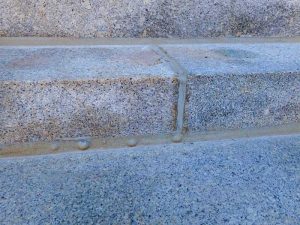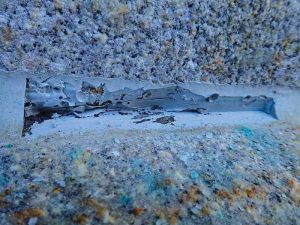Bursting the sealant bubbles


 FAILURES
FAILURES
By Deborah Slaton, David S. Patterson, AIA, and Mike Ford
On two different Midwestern projects, the surfaces of sealants exhibited gas-filled blisters, often referred to as bubbling, within a week of installation. In the first example, a light gray, one-part, neutral-cure silicone sealant was installed over a bicellular backer rod at joints between existing granite stair treads. The unprotected treads were exposed to periods of inclement weather (including snow and ice) prior to sealant installation. The contractor reported a localized heat source (‘heat gun’) was used to warm the granite substrate before installation. The installation and curing of the sealant occurred during cold weather, approximately –1 C (30 F). In the second example, a black-colored, one-part, neutral-cure silicone sealant was installed over a similar bicellular backer rod at joints between existing granite veneer panels. The sealant was installed and cured during warm weather above 32 C (90 F) with high exterior humidity.

Photos courtesy Wiss, Janney, Elstner Associates
Samples of the sealants exhibiting bubbling were removed and reviewed to understand causes of the observed surface conditions. In addition to surface anomalies, each sample exhibited spherical voids within the body of the sealant. As a bicellular backer rod was employed in each case, off-gassing of the backer rod (a common cause of surface anomalies in sealant) was not considered a potential cause of the observed bubbling. Instead, the bubbling was attributed to the presence of moisture on the surface of or within the substrate at the time of installation.
In the first example, snow and ice had been present prior to installation of the sealant, and the localized application of heat likely did not remove sufficient moisture from the stone steps. In the second example, the backer rod had been installed the day before and the sealant was added early in the morning
in order to avoid high exterior ambient temperatures and humidity. The cooler outdoor temperatures at the time the work was being completed may have resulted in the formation of condensation within the joints prior to or during sealant installation.

The sealant in the first example is scheduled to be removed and replaced during upcoming work. The sealant in the second example has been replaced to address the bubbling issue. The new sealant was installed with more careful preparation and controls to avoid the presence of moisture and has not exhibited bubbling since installation.
These examples highlight potential problems that can occur when work is not properly protected and/or is conducted near the upper and lower thresholds of the temperature range allowed by the sealant manufacturer. These problems demonstrate the benefit of specifying narrower limits for installation temperatures as well as stricter environmental controls and protection protocols—not necessarily due to the sealant material, but because of challenges associated with preparing substrates and maintaining environmental conditions at extreme temperatures.
The opinions expressed in Failures are based on the authors’ experiences and do not necessarily reflect those of The Construction Specifier or CSI.
Deborah Slaton is an architectural conservator and principal with Wiss, Janney, Elstner Associates (WJE) in Northbrook, Illinois, specializing in historic preservation and materials conservation. She can be reached at dslaton@wje.com.
David S. Patterson, AIA, is an architect and senior principal with WJE’s office in Princeton, New Jersey. He specializes in investigation and repair of the building envelope. He can be reached at dpatterson@wje.com.
Mike Ford is an architect and senior associate with WJE’s Northbrook office, specializing in historic preservation. He can be reached at mford@wje.com.



